
The Flash and Circle is a fascist symbol used by several organisations. It was first used by the British Union of Fascists (BUF), and was adopted in 1935. [1]

The Flash and Circle is a fascist symbol used by several organisations. It was first used by the British Union of Fascists (BUF), and was adopted in 1935. [1]
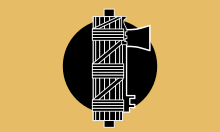

The BUF was founded in 1932 and adopted the fasces as its emblem, whose bundle of sticks represents strength through unity, and whose axe represents the supreme authority of the state to which citizens owe allegiance. Although the fasces was utilized almost exclusively by Benito Mussolini's Blackshirts, the BUF claimed that they had a right to use the symbol on the basis that the fasces was used extensively in Britain during Roman times, and that the British Empire continued to carry on the tradition of civilisation from them. [2] The symbol would officially be changed in March 1934 from the plain gold fasces to a Union Flag within a shield and a fasces placed on top. The reasons for this change was that the BUF wanted to emphasise its commitment to king and country through the addition of the national emblem, the other reason was to help the movement distinguish itself in foreign nations.[ citation needed ]
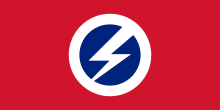
Starting in the 1930s, the fasces began to be phased out in favour of the BUF's final symbol, the Flash and Circle. In the summer of 1935, Eric H. Piercy, the commander of the Fascist Defence Force, designed the emblem and presented it to Oswald Mosley, the BUF's leader. [1] The official colors were: a white lightning bolt ("flash") and circle, a blue roundel, and a red background. The symbolism of this design was meant to convey a flash of action within a circle of unity. While there was a lack of consistency in the appearance of the Flash and Circle, such as the short-lived inverted version used in 1935, it would go on to become the main symbol of the party and was used extensively throughout 1935-1940. [1] The BUF's left-wing opponents nicknamed the symbol the "flash in the pan". [3] The usage of any symbols by the BUF would slowly decline after the party was banned and its leadership (including Mosley) was interned on 23 May 1940 under Defence Regulation 18B.[ citation needed ]
After being released from internment, Mosley would continue his political activities, creating the Union Movement (UM) in February 1948. [4] The UM would go on to adopt the Flash and Circle as its symbol. Throughout the 50s and 60s multiple branch flags were adopted using a black background with a yellow Flash and Circle with the name of the branch underneath in yellow as well. Another variant was adopted by the Mosley Youth in the early 50s. This design consisted of a red background with a black circle and a white flash. [5]
The emblem of the Bulgarian fascist party, Union of Bulgarian National Legions (SBNL) utilised a variant of the version of flash and circle, replacing the swastika. [6] The lightning bolt represented the SBNL striking at communism. [7] Eventually the emblem would replace the lightning bolt with the swastika towards the end of 1944.
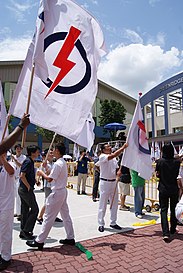
The insignia of the People's Action Party (PAP) of Singapore is composed of a red flash struck through a smaller blue circle on a white background. The PAP insignia is claimed to represent "action within social/racial unity" with the white background representing purity in thought and deed. [8] When asked about the origins of the insignia, Lee Kuan Yew—a founding member of the PAP and Singapore's first Prime Minister—"acknowledged a design influence from the BUF symbol but added that the colour scheme had been changed for the PAP logo.". [9]
The simple combination of the lightning bolt and circle has given rise to many similar designs unrelated to the fascist flash and circle. These include the logo of BoltBus, which chose the design before the similarity was ever noticed. [10] The Tampa Bay Lightning hockey team use a somewhat similar design on their primary and alternate logos. One form of warning sign for high-voltage electricity uses a lightning bolt inside a circle, and this was repurposed by Marilyn Manson as an insignia for his album Antichrist Superstar . [11] German automobile manufacturer Opel uses a horizontal lightning bolt and circle in black and white as its logo. In most cases, there is no evidence to suggest that the designer intended to evoke an association with political use of the symbol.

The flag of Europe or European flag consists of twelve golden stars forming a circle on a blue field. It is the official flag of the European Union. It was designed and adopted in 1955 by the Council of Europe (CoE) as a symbol for the whole of Europe.
Fasces is a bound bundle of wooden rods, often but not always including an axe with its blade emerging. The fasces is an Italian symbol that had its origin in the Etruscan civilization and was passed on to ancient Rome, where it symbolized a Roman king's power to punish his subjects, and later, a magistrate's power and jurisdiction. The axe has its own separate and older origin. Initially associated with the labrys, the double-bitted axe originally from Crete, is one of the oldest symbols of Greek civilization.

Sir Oswald Ernald Mosley, 6th Baronet was a British aristocrat and politician who rose to fame during the 1920s and 1930s when, having become disillusioned with mainstream politics, he turned to fascism. He was a member of parliament and later founded and led the British Union of Fascists (BUF).
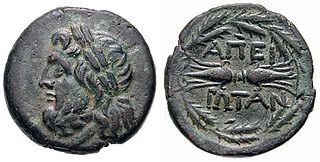
A thunderbolt or lightning bolt is a symbolic representation of lightning when accompanied by a loud thunderclap. In Indo-European mythology, the thunderbolt was identified with the 'Sky Father'; this association is also found in later Hellenic representations of Zeus and Vedic descriptions of the vajra wielded by the god Indra. It may have been a symbol of cosmic order, as expressed in the fragment from Heraclitus describing "the Thunderbolt that steers the course of all things".

The British Union of Fascists (BUF) was a British fascist political party formed in 1932 by Oswald Mosley. Mosley changed its name to the British Union of Fascists and National Socialists in 1936 and, in 1937, to the British Union. In 1939, following the start of the Second World War, the party was proscribed by the British government and in 1940 it was disbanded.

Totenkopf is the German word for skull. The word is often used to denote a figurative, graphic or sculptural symbol, common in Western culture, consisting of the representation of a human skull- usually frontal, more rarely in profile with or without the mandible. In some cases, other human skeletal parts may be added, often including two crossed long bones (femurs) depicted below or behind the skull. The human skull is an internationally used symbol for death, the defiance of death, danger, or the dead, as well as piracy or toxicity.

The flag of the United Nations is a sky blue banner containing the United Nations' emblem in the centre. The emblem on the flag is coloured white; it is a depiction of the world map in the azimuthal equidistant projection, which is surrounded by a pair of olive branches. The emblem was officially adopted on 7 December 1946, and the flag containing the emblem was officially adopted on 20 October 1947.

A red star, five-pointed and filled, is a symbol that has often historically been associated with communist ideology, particularly in combination with the hammer and sickle, but is also used as a purely socialist symbol in the 21st century. It has been widely used in flags, state emblems, monuments, ornaments, and logos.

The coat of arms of France is an unofficial emblem of the French Republic. It depicts a lictor's fasces upon branches of laurel and oak, as well as a ribbon bearing the national motto of Liberté, égalité, fraternité. The full achievement includes the star and grand collar of the Legion of Honour. This composition was created in 1905 by heraldic painter-engraver Maurice de Meyère, and it has been used at the Foreign Ministry during state visits and for presidential inaugurations.

The Imperial Fascist League (IFL) was a British fascist political movement founded by Arnold Leese in 1929 after he broke away from the British Fascists. It included a blackshirted paramilitary arm called the Fascists Legion, modelled after the Italian Fascists. The group espoused antisemitism and the dominance of the 'Aryan race' in a 'Racial Fascist Corporate State', especially after Leese met Nazi Party propagandist Julius Streicher, the virulently racist publisher of Der Stürmer; the group later indirectly received funding from the Nazis. Although it had only between 150 and 500 members at maximum, its public profile was higher than its membership numbers would indicate.
Fascist symbolism is the use of certain images and symbols which are designed to represent aspects of fascism. These include national symbols of historical importance, goals, and political policies. The best-known are the fasces, which was the original symbol of fascism, and the swastika of Nazism.

Alexander Raven Thomson, usually referred to as Raven, was a Scottish politician and philosopher. He joined the British Union of Fascists in 1933 and remained a follower of Oswald Mosley for the rest of his life. Thomson was considered to be the party's chief ideologue and has been described as the "Alfred Rosenberg of British fascism".

Superman shield, also known as the Superman logo or the Superman symbol, is the iconic emblem for the fictional DC Comics superhero Superman. As a representation of one of the first superheroes, it served as a template for character design decades after Superman's first appearance. The tradition of wearing a representative symbol on the chest was followed by many subsequent superheroes, including Batman, Green Lantern, the Flash, Wonder Woman, Hawkman, and many others.
BBC One used a number of different idents from the time of the station launch on 2 November 1936 until the station took on the Mirror Globe Idents on 15 November 1969.
Communist symbolism represents a variety of themes, including revolution, the proletariat, the peasantry, agriculture, or international solidarity. The red flag, the hammer and sickle and the red star or variations thereof are some of the symbols adopted by communist movements, governments, and parties worldwide.

The logo of the luxury automaker Ferrari is the Prancing Horse, a prancing black horse on a yellow background. The design was originally created by Francesco Baracca, an Italian flying ace during World War I, as an insignia to be displayed on his aeroplane; the Baracca family later gave Enzo Ferrari permission to use the design. The logo has been used by Scuderia Ferrari—Ferrari's racing team, subsidiary, and immediate predecessor—since 1932, and was applied to the company's sports cars beginning in 1947.
The Fascist Defence Force (FDF) was the paramilitary section of the British Union of Fascists (BUF).
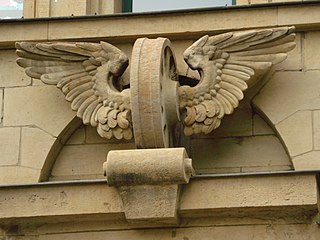
A winged wheel is a symbol used historically on monuments by the ancient Greeks and Romans and more recently as a heraldic charge. The symbol was associated with the ancient Greek god Hermes. In heraldry the symbol has been used to represent transport, speed and progress. A three-winged wheel was chosen as the logo of the British Cyclists' Touring Club and at one point was considered "cycling’s most famous symbol". A two-winged version formed the logo of the London General Omnibus Company and, after a merger, formed the basis of the modern London Underground roundel.

The coat of arms of McGill University is the official emblem of the university and derives from a heraldic device assumed during the lifetime of the university's founder, James McGill. The first iteration was designed in 1906 by Percy Nobbs, then director of the McGill School of Architecture. The design subsequently varied for decades after until the university's current coat of arms, largely resembling the original design, was finally adopted by the Board of Governors in 1975. Today, the university has approved multiple logos across its faculties and departments, including a separate coat of arms used by the Macdonald Campus.

The coat of arms of Gran Colombia was adopted in 1821.
The insignia that represents the Antichrist Superstar album ... also echoes the insignia of Oswald Moseley's British Union of Fascists...